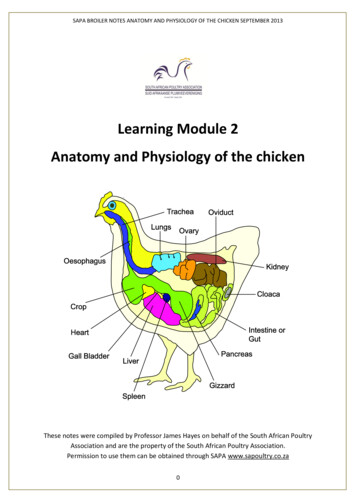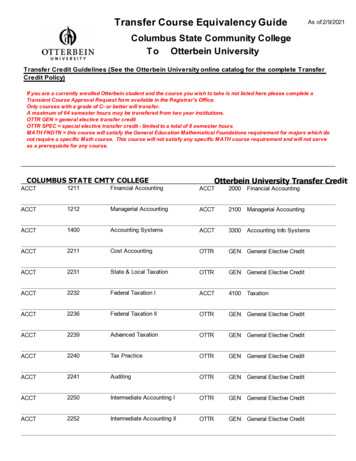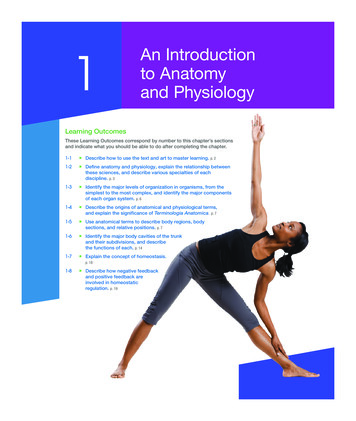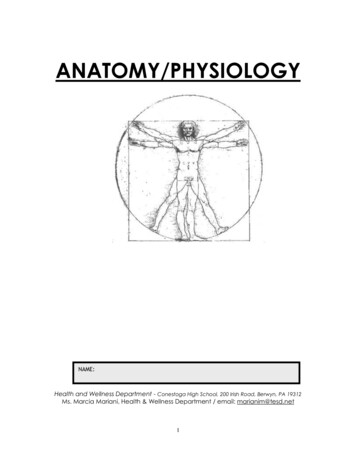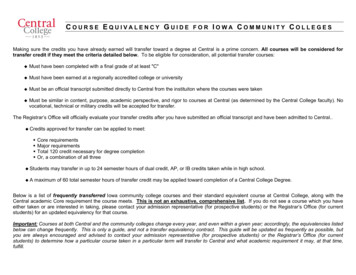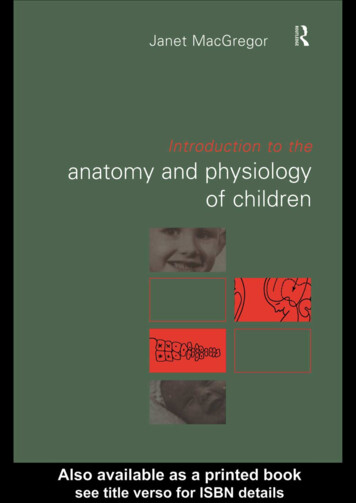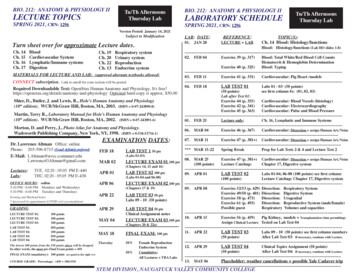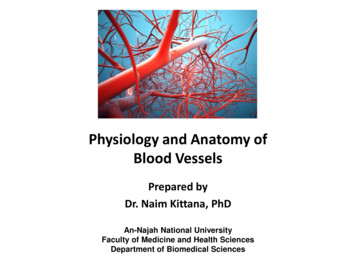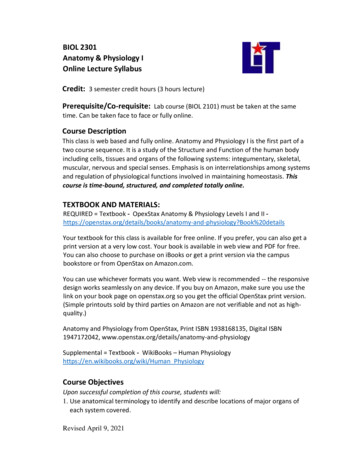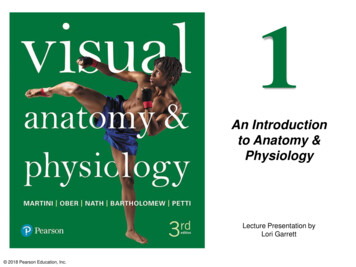
Transcription
1An Introductionto Anatomy &PhysiologyLecture Presentation byLori Garrett 2018 Pearson Education, Inc.
Section 1: An Introduction to Studying theHuman Body Learning Outcomes1.1 Briefly describe the difference between anatomyand physiology.1.2 Describe how to use the text and art together tomaster learning.1.3 Explain how to approach complex concepts withmultiple parts.1.4 Describe the anatomical position and how youshould view sectional images.1.5 Explain the significance of learning outcomes inacquiring knowledge and skills. 2018 Pearson Education, Inc.
Module 1.1: Using your textbook effectively iskey to your success Anatomy—structure Physiology—function Structure determines function Biology—the study of life Illustrations are especially important 2018 Pearson Education, Inc.
Module 1.1: ReviewA. What is human A&P?B. Define the term biology.Learning Outcome: Briefly describe the differencebetween anatomy and physiology. 2018 Pearson Education, Inc.
Module 1.2: Comprehending the art is essentialto understanding A&P Integrate informationin art and words forsuccess Research with eyetracking equipmentshows that learningand comprehensionlevels are greater forstudents who studiedart and text together Art and text go handin hand 2018 Pearson Education, Inc.
Module 1.2: Comprehending the art is essential Text-art integration—no page flipping orhunting for illustrationassociated with text Text and art arecombined, with keytext in the art itself 2018 Pearson Education, Inc.
Module 1.2: ReviewA. What do eye-tracking studies tell us about themost effective way to learn?B. Try this experiment. Pick one of the twoexamples, cover up the text, and focus solelyon the art. What did you discover?Learning Outcome: Describe how to use the textand art together to master learning. 2018 Pearson Education, Inc.
Module 1.3 Break down the art in step-wisefashion to learn the topic Tasks becomeeasier whenbroken down Start with the key With figures withsteps, begin withstep 1 and follownumerical order 2018 Pearson Education, Inc.
Module 1.3: Break down the art Read left-to-right, column-by-column Every new one- or two-page module starts with atitle Look for numbered red blocks Read the text and study the image Answer review questions Move on to next numbered red block At completion of the module, answer theintegration questions 2018 Pearson Education, Inc.
Break down the art 2018 Pearson Education, Inc.
Module 1.3: ReviewA. Calculate the area in blue. All numbers are incentimeters (cm).Learning Outcome: Explain how to approachcomplex concepts with multiple parts. 2018 Pearson Education, Inc.
Module 1.4 Orient yourself to all art in the sameway Anatomical position Standing erect, face forward (anteriorly), arms atside, palms anterior facing Lying face up in supine position Find point of reference and put yourself in positionof images 2018 Pearson Education, Inc.
Module 1.4 Orient yourself to all art in the sameway In this text, all body cross sections are from sameperspective To read, orient as if standing at feet of person who isin supine position, looking up toward the head 2018 Pearson Education, Inc.
Module 1.4: ReviewA. Look at the woman standing.On which wrist is her braceletfound? 2018 Pearson Education, Inc.
Module 1.4: ReviewB. What is the structuremarked with an X inthe MRI scan?Learning Outcome: Describe the anatomical positionand how you should view sectional images. 2018 Pearson Education, Inc.
Module 1.5: Learning Outcomes correspond tomodules and what you should be able to doafter completing chapter Module—independent, self-contained unit abouta specific topic Section—set of modules placed in a series thatare interdependent Learning Outcomes—educational objectivesthat use key verbs to target knowledge,comprehension, and specific skills 2018 Pearson Education, Inc.
Module 1.5: Learning Outcomes correspond tomodules Learning classification scheme—identifiesfundamental levels of learning, from lower-orderthinking to higher-order skills Read the text, study the image, and pay attentionto Learning Outcomes for success 2018 Pearson Education, Inc.
Module 1.5: ReviewA. Define module, and state where the LearningOutcomes appear.B. Describe learning classification scheme.Learning Outcome: Explain the significance oflearning outcomes in acquiring knowledge andskills. 2018 Pearson Education, Inc.
Section 2: A&P in PerspectiveLearning Outcomes1.6 Describe homeostasis, and identify basic studyskill strategies to use in this course.1.7 Describe the common characteristics of life andthe basic processes in humans and other animals.1.8 Define anatomy and physiology, and describemacroscopic and microscopic anatomy.1.9 Explain the relationship between structure andfunction. 2018 Pearson Education, Inc.
Module 1.6: Focused study is important forlearning anatomy and physiology Basic approach in studyingA&P: “What is thestructure, and how doesit work?” “Black Box” When you know whatsomething does but not how One of the most importantconcepts to learn: Homeostasis A relatively stable internalenvironment 2018 Pearson Education, Inc.
Module 1.6: ReviewA. What do scientists mean when they use theterm “Black Box”?B. Identify several strategies for success in thiscourse.Learning Outcome: Describe homeostasis, andidentify basic study skill strategies to use in thiscourse. 2018 Pearson Education, Inc.
Module 1.7: Organisms share commoncharacteristics and processesCharacteristics of allliving things1. Composed of cells2. Complex structuralarrangement3. Detect and respond tostimuli4. Maintain a relativelystable internalenvironment 2018 Pearson Education, Inc.
Module 1.7: Organisms share commoncharacteristics and processesCharacteristics of all living things (continued)5. Organisms grow (increase in size) and develop(natural progression in physical maturation)6. Offspring are produced by reproduction7. Have metabolism—allessential chemical processesoccurring in cells Anabolic—building up Catabolic—breaking down 2018 Pearson Education, Inc.
Module 1.7: Organisms share commoncharacteristics and processesProcesses of life Respiration—oxygen required forchemical processes obtained fromatmosphere and delivered tocardiovascular system; carbondioxide removed by cardiovascularsystem Digestion—mechanical andchemical process to convertingested food into simpleabsorbable substances 2018 Pearson Education, Inc.
Module 1.7: Organisms share commoncharacteristics and processesProcesses of life (continued) Circulation—internal movementand distribution of oxygen, wastes,and digestion products Excretion—undigested food andwastes of metabolism eliminatedfrom body 2018 Pearson Education, Inc.
Module 1.7: ReviewA. List the common characteristics shared by allliving things.B. Distinguish between growth and development.C. Describe the basic processes in humans andother animals.Learning Outcome: Describe the commoncharacteristics of life and the basic processes inhumans and other animals. 2018 Pearson Education, Inc.
Module 1.8: Anatomy is the study of structure Anatomy—means “acutting open” Study of the structuresof the body and physicalrelationships amongbody parts Gross (macroscopic)anatomy—largestructures and featuresusually visible withunaided eye 2018 Pearson Education, Inc.
Module 1.8: Anatomy is the study of structure Microscopic anatomy Study of structures that cannot be seen withoutmagnification Dissecting microscope—can see tissues Light microscope—cansee basic cell structure Electron microscope—cansee individual molecules 2018 Pearson Education, Inc.
Module 1.8: and physiology is the study offunctionPhysiology Study of function and how organisms perform vitalfunctions Complex and more difficult to examine thananatomical structures Focuses on functional properties 2018 Pearson Education, Inc.
Module 1.8: and physiology is the study offunctionExamples of physiology topics Electrical events within the heart coordinating theheartbeat and pressure changes 2018 Pearson Education, Inc.
Module 1.8: ReviewA. What are the differences between grossanatomy and microscopic anatomy?B. Explain the link between anatomy andphysiology.Learning Outcome: Define anatomy andphysiology, and describe macroscopic andmicroscopic anatomy. 2018 Pearson Education, Inc.
Module 1.9: Structure and function areinterrelatedPhysiology and anatomy are closelyinterrelated in theory and in practice One cannot be fully understood without the other Anatomical details have an effect on function Physiological mechanisms are understood in terms ofunderlying structural relationships 2018 Pearson Education, Inc.
Module 1.9: Structure and function areinterrelatedExamples The elbow joint is an example of interrelationshipbetween structure and function at the grossanatomy level Functions like a hinge Allows movement in one plane– Forearm moves toward or away from shoulder, butdoes not twist Anatomical structures impose functional limits 2018 Pearson Education, Inc.
Module 1.9: Structure and function areinterrelated 2018 Pearson Education, Inc.
Module 1.9: Structure and function areinterrelatedChemical level example Chemical messengersand cellular receptors Cells communicate usingspecifically shapedmolecules calledchemical messengers Receptors on target cellsreceive the messageonly if the messengermolecule fits the shapeof receptor 2018 Pearson Education, Inc.
Module 1.9: Structure and function areinterrelatedLiving systems are subject to laws of physicsand chemistry Many advances in understanding the human bodycame after advances in physical or applied sciences William Harvey– Demonstrated that heart valves worked on sameprinciples as valves in coal mine water pumps 2018 Pearson Education, Inc.
Module 1.9: ReviewA. Compare the functioning of the elbow joint witha door on a hinge.B. Predict what would happen to the function of astructure if its anatomy were altered.C. What features are common to forearmmovement at an elbow joint and the opening ofa cell membrane passageway?Learning Outcome: Explain the relationshipbetween structure and function. 2018 Pearson Education, Inc.
Section 3: Levels of OrganizationLearning Outcomes1.10 Describe the various levels of organization in thehuman body.1.11 Describe various types of cells in the humanbody, and explain the basic principles of the celltheory.1.12 Define histology, and explain theinterrelationships among the various types oftissues.1.13 Identify the 11 organ systems of the human body,and describe the major functions of each. 2018 Pearson Education, Inc.
Section 3: Levels of OrganizationLearning Outcomes (continued)1.14 Describe the major organs of the integumentary,skeletal, muscular, and nervous systems, andbriefly describe their functions.1.15 Describe the major organs of the endocrine,cardiovascular, lymphatic, and respiratorysystems, and briefly describe their functions.1.16 Describe the major organs of the digestive,urinary, and reproductive systems, and brieflydescribe their functions. 2018 Pearson Education, Inc.
Module 1.10: The human body has multipleinterdependent levels of organizationLevels of organization The human body is complex, representing multiplelevels of organization Each level more complex than underlying one All can be broken down to similar chemical andcellular components 2018 Pearson Education, Inc.
Module 1.10: Interdependent levels oforganizationChemical level (Chapter 2) Atoms (smallest stable units of matter) combine toform molecules Functional properties of molecule determined byshape and atomic components 2018 Pearson Education, Inc.
Module 1.10: Interdependent levels oforganizationCellular level (Chapter 3) Cells are the smallest living units in the body Functions depend on organelles (composed ofmolecules) Each organelle has a specific function Example: a mitochondrion provides energy for heartmuscle cell contraction 2018 Pearson Education, Inc.
Chemical and cellular levels of organization 2018 Pearson Education, Inc.
Module 1.10: Interdependent levels oforganizationTissue level (Chapter 4) A tissue is a group of cells working together toperform specific functions Example: heart muscle cells form cardiac muscletissueOrgan level An organ is composed of two or more tissuesworking together to perform specific functions Example: layers of cardiac muscle tissue along withconnective tissue form the heart 2018 Pearson Education, Inc.
Tissue and organ levels of organization 2018 Pearson Education, Inc.
Module 1.10: Interdependent levels oforganizationOrgan system level (Chapters 5–27) Organ systems consist of interacting organs Example: the heart works with blood vessels andblood to form the cardiovascular systemOrganism level An organism is the highest level of organization Collection of organ systems working together tomaintain life and health 2018 Pearson Education, Inc.
Organ system and organism levels oforganization 2018 Pearson Education, Inc.
Module 1.10: Interdependent levels oforganization 2018 Pearson Education, Inc.
Module 1.10: ReviewA. Name the simplest level of organization thatincludes the smallest living units in the body.B. Define organ.C. Our understanding of how the human bodyworks is based on a knowledge of whichlevel(s) of organization?Learning Outcome: Describe the various levels oforganization in the human body. 2018 Pearson Education, Inc.
Module 1.11: Cells are the smallest units of lifeFree-living cells Smallest living structuresMost plants and animals are multicellular Containing thousands to billions of cellsCells in the human body Contains trillions of cellsOnly an estimated 200 different types of cellsMeasured in micrometersVary greatly in size 2018 Pearson Education, Inc.
Module 1.11: Cells are the smallest units of lifeCell function is related to its structure Smooth muscle cells—long and slender forcontraction Red blood cells—flattened discs to transport oxygenand carbon dioxide Bone cells—maintain bone Fat cells—spherical for fat storage Cells lining digestive tract—shaped for absorption Reproductive—few large oocytes; numerous sperm Nerve cells—some have extensive branchingproviding huge surface area for communication 2018 Pearson Education, Inc.
Module 1.11: Cells are the smallest units of life 2018 Pearson Education, Inc.
Module 1.11: Cells are the smallest units of lifeCell theory—foundation of modern biology 2018 Pearson Education, Inc.
Module 1.11: CellsCells work together Human life depends on cells working together Each cell responds to its local environmentindependently Cells in different parts of the body are coordinatedand controlled 2018 Pearson Education, Inc.
Module 1.11: ReviewA. Name and define the unit used to measurecell size.B. List the three basic principles of the cell theory.C. A red blood cell has a diameter of about 8 µm.Use that information to estimate the diameter ofthe oocyte in micrometers (µm) and millimeters(mm). (1 mm 1000 µm)Learning Outcome: Describe various types of cellsin the human body, and explain the basic principlesof the cell theory. 2018 Pearson Education, Inc.
Module 1.12: Tissues are specialized groups ofcells and cell productsTissues are collections of similar cells and cellproducts that perform specific functions Histology (histos, tissue) is the study of tissues. Four primary tissue types1.2.3.4.Epithelial tissueConnective tissueMuscle tissueNervous tissue 2018 Pearson Education, Inc.
Module 1.12: TissuesEpithelial tissue Most common Forms a barrier withspecific properties Covers every exposedbody surface Lines digestive, respiratory,reproductive, and urinarytracts Surrounds internal cavities (e.g., chest cavity) Lines inner surfaces of blood vessels and heart Produces glandular secretions 2018 Pearson Education, Inc.
Module 1.12: TissuesConnective tissue Diverse in appearance butall forms contain cellssurrounded by extracellularmatrix Matrix composed of:– Protein fibers– Ground substance (liquid) Amount and consistency ofmatrix varies by theparticular connective tissue type– Blood—watery matrix– Bone—crystallized matrix with little ground substance 2018 Pearson Education, Inc.
Module 1.12: TissuesMuscle tissue Has the ability to contractforcefully Major functions Skeletal movement Soft tissue support Maintenance of blood flow Movement of materialsinternally Stabilization of bodytemperature 2018 Pearson Education, Inc.
Module 1.12: TissuesMuscle tissue (continued) Three types1. Skeletal– Usually attached to the skeleton– Moves or stabilizes position of skeleton or internalorgans2. Cardiac– Found only in the heart– Propels blood through blood vessels3. Smooth– Found in blood vessel walls, within glands, alongrespiratory, circulatory, digestive, and reproductivetracts 2018 Pearson Education, Inc.
Module 1.12: TissuesNervous tissue Specialized to carryinformation or instructionswithin the body Two basic types of cells1. Neurons (nerve cells)– Transmit information inform of electrical impulses2. Neuroglia (supporting cells)– Isolate and support neurons– Form supporting framework 2018 Pearson Education, Inc.
Module 1.12: TissuesNeural tissue locations within the body1. Central nervous system Brain and spinal cord2. Peripheral nervous system Nerves connecting central nervous system with othertissues and organs 2018 Pearson Education, Inc.
Module 1.12: ReviewA. Describe the general roles of the different typesof muscle tissue.B. Identify the four primary tissue types, andexplain the functions of each.Learning Outcome: Define histology and explainthe interrelationships among the various types oftissues. 2018 Pearson Education, Inc.
Module 1.13: Organs and organ systemsperform vital functionsOrgan Functional unit composed of more than one tissuetype Function determined and limited by specificcombination and organization of tissues within it For example:– Organ with flattened shape could function well inprotection (skin)– Organ with three-dimensional shape could house otherstructures (liver) 2018 Pearson Education, Inc.
Module 1.13: Organs and organ systemsThe heart has cardiac muscle, epithelial tissue, connectivetissue, and neural tissue, which all work together as a pump. 2018 Pearson Education, Inc.
Module 1.13: Organs and organ systemsOrgan system—Consistsof organs that interact toperform a specific range offunctions, often incoordinated fashion Eleven organ systems inthe human body None of these systemsfunction in isolation All are interdependent oneach other 2018 Pearson Education, Inc.
Module 1.13: ReviewA. Which two organ systems are involved withcirculation within the body?B. Using the table as a reference, describe howfalling down a flight of stairs could affect at leastsix of the organ systems.Learning Outcome: Identify the 11 organ systemsof the human body, and describe the majorfunctions of each. 2018 Pearson Education, Inc.
Module 1.14: Organs of the integumentary,skeletal, and muscular systems support andmove the body Integumentary system Protects the body from environmental hazards Helps control body temperatureSkeletal system Provides supportProtects tissuesStores mineralsForms blood cells 2018 Pearson Education, Inc.
Integumentary system 2018 Pearson Education, Inc.
Skeletal system 2018 Pearson Education, Inc.
Module 1.14: Organ systems (part 1)Muscular system Produces movement Provides support Generates heatNervous system Provides rapid control and regulation Coordinates activities of other organ systems 2018 Pearson Education, Inc.
Muscular system 2018 Pearson Education, Inc.
Nervous system 2018 Pearson Education, Inc.
Module 1.14: ReviewA. How would a nervous system disorder affect themuscular system?Learning Outcome: Describe the major organs ofthe integumentary, skeletal, muscular, and nervoussystems, and briefly describe their functions. 2018 Pearson Education, Inc.
Module 1.15: Organ systems (part 2)Endocrine system Secretes chemical messengers Directs long-term changes in other systemsCardiovascular system Transports cells and dissolved materials, includingnutrients, hormones, wastes, and gases to all partsof the body 2018 Pearson Education, Inc.
Endocrine system 2018 Pearson Education, Inc.
Cardiovascular system 2018 Pearson Education, Inc.
Module 1.15: Organ systems (part 2)Lymphatic system Defends the body against infection and disease Returns tissue fluid to bloodstreamRespiratory system Delivers air to gas exchange sites in lungs Produces sound 2018 Pearson Education, Inc.
Lymphatic system 2018 Pearson Education, Inc.
Respiratory system 2018 Pearson Education, Inc.
Module 1.15: ReviewA. How would a respiratory system disease affectthe cardiovascular system?Learning Outcome: Describe the major organs ofthe endocrine, cardiovascular, lymphatic, andrespiratory systems, and briefly describe theirfunctions. 2018 Pearson Education, Inc.
Module 1.16: Organ systems (part 3)Digestive system Processes food and absorbs nutrientsUrinary system Eliminates excess water, salts, and wastesReproductive system Produces sex cells and hormones (male andfemale) Supports embryonic development from fertilizationto birth (female only) 2018 Pearson Education, Inc.
Digestive system 2018 Pearson Education, Inc.
Urinary system 2018 Pearson Education, Inc.
Female reproductive system 2018 Pearson Education, Inc.
Male reproductive system 2018 Pearson Education, Inc.
Module 1.16: ReviewA. How would a reproductive system disorderaffect the urinary system?Learning Objective: Describe the major organs ofthe digestive, urinary, and reproductive systems,and briefly describe their functions. 2018 Pearson Education, Inc.
Section 4: HomeostasisLearning Outcomes1.17 Describe the mechanisms of homeostaticregulation.1.18 Discuss the roles of negative feedback andpositive feedback in maintaininghomeostasis. 2018 Pearson Education, Inc.
Module 1.17: Homeostatic regulation relies on areceptor, a control center, and an effectorHomeostasis (homeo, unchanging stasis,standing) Presence of stable internal environment Failure to maintain homeostasis leads to illness ordeathHomeostatic regulation Physiological adjustment to preserve homeostasisin variable environments 2018 Pearson Education, Inc.
Module 1.17: Homeostatic regulationComponents of a homeostatic regulatorymechanism Receptor (sensor) Sensitive to environmental change Control center (integration center) Processes information from the receptor and sendsout commands Effector Responds tocommandsopposingstimulus 2018 Pearson Education, Inc.
Module 1.17: Homeostatic regulationHomeostatic control is not precise Maintains a normal range around the set point Actual value oscillates For example:– House thermostat set at 72ºF– Actual temperature in the house ranges a few degreesabove and below that set point 2018 Pearson Education, Inc.
Module 1.17: ReviewA. Why is homeostatic regulation important to anorganism?B. Describe the three parts necessary forhomeostatic regulation.C. The Appendix contains tables of the normalphysiological values regarding dissolvedmaterials in various body fluids. Most of thesevalues are listed as ranges, rather thanaverages. Why?Learning Outcome: Describe the mechanisms ofhomeostatic regulation. 2018 Pearson Education, Inc.
Module 1.18: Negative feedback providesstability Feedback Stimulation of a receptor triggers response thatchanges environment at that receptorNegative feedback Effector opposes or negates the original stimulus Minimizes change Primary mechanism of homeostatic regulation in thebody Dynamic process Set point varies with varying environments andactivity levels 2018 Pearson Education, Inc.
Negative feedback of temperature regulation 2018 Pearson Education, Inc.
Negative feedback of temperature regulation 2018 Pearson Education, Inc.
Negative feedback of temperature regulation 2018 Pearson Education, Inc.
Negative feedback of temperature regulation 2018 Pearson Education, Inc.
Module 1.18: Negative versus positive feedbackOver time in a warm environment, the bodytemperature can decline past the set point, due tosweat that has been secreted evaporating. 2018 Pearson Education, Inc.
Module 1.18: and positive feedbackaccelerates a process to completionPositive feedback Stimulus produces a response that exaggerates orenhances the original change (rather thanopposing it) Tends to produce extreme responses Does not restore homeostasisPositive feedback loop Escalating cycle Typically occurs when a potentially dangerous orstressful process must be completed quickly beforethe body can restore homeostasis 2018 Pearson Education, Inc.
Blood clotting is positive feedback 2018 Pearson Education, Inc.
Blood clotting is positive feedback 2018 Pearson Education, Inc.
Blood clotting is positive feedback 2018 Pearson Education, Inc.
Blood clotting is positive feedback 2018 Pearson Education, Inc.
Blood clotting is positive feedback 2018 Pearson Education, Inc.
Module 1.18: ReviewA. Explain the function of negative feedbacksystems, and give an example of homeostaticregulation by negative feedback in the body.B. Why is positive feedback helpful in bloodclotting but unsuitable for regulating bodytemperature?Learning Outcome: Discuss the roles of negativefeedback and positive feedback in maintaininghomeostasis. 2018 Pearson Education, Inc.
Section 4: Anatomical TermsLearning Outcomes1.19 Describe the history of anatomical terminology.1.20 Use correct anatomical terms to describesuperficial and regional anatomy.1.21 Use correct directional terms and sectionalplanes to describe relative positions andrelationships among body parts.1.22 Identify the major body cavities of the trunk andthe subdivisions of each. 2018 Pearson Education, Inc.
Module 1.19: Anatomical terms have a long andvaried historyOrientation to the body Landmarks around the body create a map fororientation Anatomy uses a special language, with many termsbased on Latin or Greek words used by ancientanatomists Vocabulary continues to expand 2018 Pearson Education, Inc.
Module 1.19: Anatomical termsSome eponyms (things named after the discovereror most famous victim of a disease) persist; manyreplaced by more precise terms 2018 Pearson Education, Inc.
Module 1.19: Anatomical termsHistory of anatomical studies Anatomical studies bymedical professionals ina European university canbe traced to Universityof Bologna in Italy Anatomia text writtenby Mondino dei Liuzzi Anatomical study improvedat University of Padua De Humani Corporis Fabricaby Andreas Vesalius published in 1543 Served as early model for modern anatomy education 2018 Pearson Education, Inc.
Module 1.19: ReviewA. Which languages are the source of manymodern anatomical terms?B. Define the word eponym.C. In what country was cadaver-based anatomyestablished as a discipline studied by medicalprofessionals?Learning Outcome: Describe the history ofanatomical terminology. 2018 Pearson Education, Inc.
Module 1.20: Superficial anatomy and regionalanatomy indicate locations on or in the body Anatomical position is thebody: Standing upHands at the sidesPalms facing forwardFeet together and facingforward 2018 Pearson Education, Inc.
Module 1.20: Superficial anatomy and regionalanatomy indicate locations on or in the body Anatomical position is thebody (continued): Eyes facing forward Lying down in anatomicalposition Supine when face up Prone when face down 2018 Pearson Education, Inc.
Common anatomical terms aid in effectivecommunication 2018 Pearson Education, Inc.
Module 1.20: Superficial and regional anatomyThere are four abdominopelvic quadrants Formed by pair of imaginary perpendicular lines thatintersect at navel Used by clinicians to describe locations of patientpains, aches, or injuries Location can helpphysicians determinepossible cause of pain 2018 Pearson Education, Inc.
Module 1.20: Superficial and regional anatomy There are nine abdominopelvic regions Used by anatomists to describe precise locationand orientation of internal organs More precise thanabdominopelvicquadrants 2018 Pearson Education, Inc.
Module 1.20: Superficial and regional anatomyTaken together, the abdominopelvic regions andquadrants are able to help identify organ locationsin the body 2018 Pearson Education, Inc.
Module 1.20: ReviewA. Describe a person in the anatomical position.B. A massage therapist often begins a massage byasking clients to lie face down with their arms attheir sides. Which anatomical term describes thatposition?C. Contrast the descriptions used by clinicians andanatomists when referring to the positions of injuriesor internal organs of the abdomen and pelvis.D. What is the purpose of anatomical terms?Learning Outcome: Use correct anatomical terms todescribe superficial and regional anatomy. 2018 Pearson Education, Inc.
Module 1.21: Directional terms and sectionalplanes describe specific points of referenceDirectional terms Used to describe specific points of reference All directions utilize anatomical position as standardpoint of reference Many different terms, often interchangeable Anterior or ventral Posterior or dorsal Other directional terms: Superficial—near the surface Deep—toward interior of body 2018 Pearson Education, Inc.
Module 1.21: Directional and sectional terms 2018 Pearson Education, Inc.
Mod
Module 1.1: Using your textbook effectively is key to your success Anatomy—structure Physiology—function Structure determines function Biology

